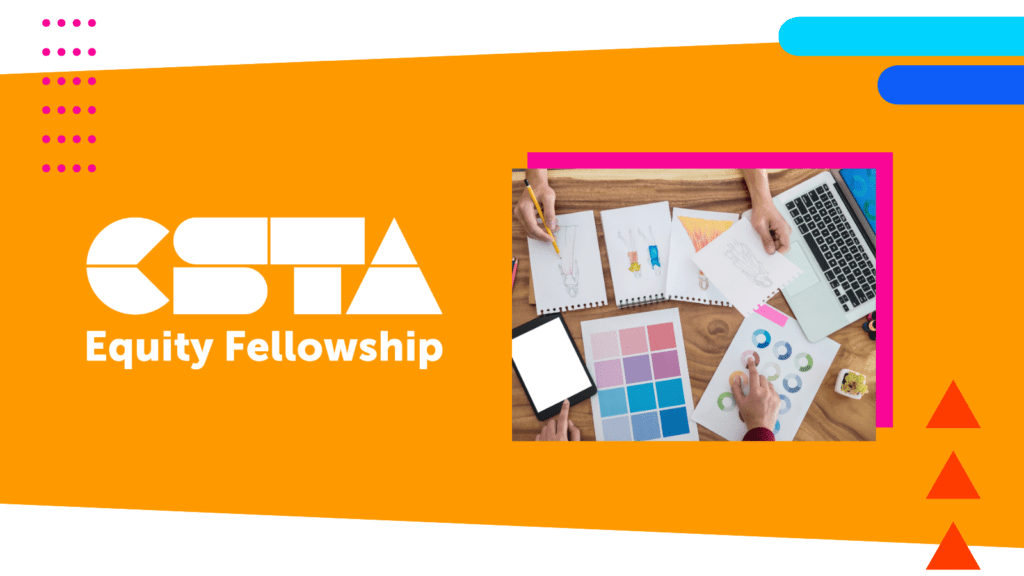Have you ever walked into a professional development experience thinking, “What version of myself will I be in this space?” Is code switching something that you have to navigate on a daily basis? As an educator, you’re well aware that students do the same thing as they discover who they are and explore new interests. Many identity components make a person who they are — name, interests, spoken language, ethnic background, religious beliefs, income, level of education, home experiences, friends, community, likes, dislikes, etc. All of these pieces, when put together, show the intersectionality of identity and potentially a multitude of entry points into computer science (CS) education.
As an educator, administrator, and computer science leader in the field of CS education, I have stumbled across the same barrier time and time again — many teachers, administrators, and students struggle with seeing how ‘computer scientist’ can be added as one of the intersecting layers of their identity. In the digital age in which we live, there are so many ways to consume information, but what about the flip side, where consumers instead become creators and contributors?
Creating vs Consuming Based on Identity
The things that we are passionate about are a key part of who we are. While working with students, teachers, and administrators, this is where the magic of unveiling a CS identity can happen. CS, much like the intersectionality of one’s identity, can be integrated into so many different areas of interest: student engagement, projects for social good, development in art, all core subject areas — the list goes on and on. When something we are interested in becomes a component of our learning, we are more inclined to engage. For example, I worked with a student who sketched fashion ideas on her notes constantly and always brought up the art of clothing design when she could in her assignments. Her style showed her heritage, something she was clearly proud of. She scored well in all academic areas and was great at critical and computational thinking. When an after-school coding club was offered, I told her I thought she may enjoy it, and she told me coding was for not for people like her as she felt it was for boys, and that she’d rather draw her fashion designs because that was more for girls. I shared that the coding club was specifically for girls and that she could tie in her interest in fashion. With great hesitation, she signed up and attended the after-school coding club. Once she saw what she could do, and how she could tie her interest into computer science, she was hooked and there was no stopping her. This young lady ended up in a fashion school and added computer science to her designs in ways that may seem unimaginable to others.
The Importance of Seeing Reflections in Computer Science
What does your reflection actually show? There is surface-level reflection and internal reflection (who we are beneath the surface that cannot be seen by others). Each one of the pieces that make us who we are through our personal kaleidoscope of intersectionality could be considered a bridge to computer science. Take, for example, those of us who are musicians; there are multiple apps and programs that were developed by computer scientists who love music and created digital tools, like a metronome or an instrument tuner. Who would have thought that a small physical computing device like a tuner would be able to indicate the correct sound through the vibrations of a string? Think of the person who has an aging family member who cannot remember to take their medication on time. Computer science can be used to create devices like the ones in many homes to set reminders, play, music, make calls, and so much more. There are a plethora of areas in which individuals may see themselves based on their identities and are able to find alignment to self and creativity as they develop solutions through the use of computer science.
As educators, it is important to remember that like us, our students have many pieces that make them who they are, and we can lean on these components to engage them in computer science education. Like a skeleton key, tapping into what is meaningful to each student can open doors through the conduit of CS to a promising future with creations that can potentially change the world.
About the Author

Dr. Sharisa Chan is the Associate Director of Curriculum, Instruction, and Professional Development for UCLA Center X’s Computer Science Equity Project. Previously, she served as a county administrator at the San Bernardino County Superintendent of Schools, focusing on equitable computer science and technology integration in education. She led sessions on Equity Minded Instruction in Computer Science for Seasons of CS and organized Innovation Day events, offering underrepresented students hands-on experience with physical computing tools tied to Global Sustainable Development Goals. Additionally, Dr. Chan provided professional development for TK-12 teachers on integrating computer science into their curricula. She holds a doctorate in Educational Leadership with a focus on Curriculum and Instruction, a master’s degree in Education from UC Riverside, and a bachelor’s degree in Liberal Studies. Dr. Chan is passionate about expanding computer science education and fostering interdisciplinary connections in the classroom.

